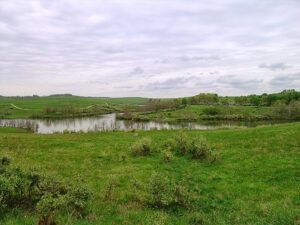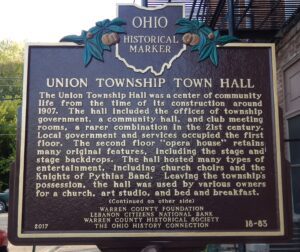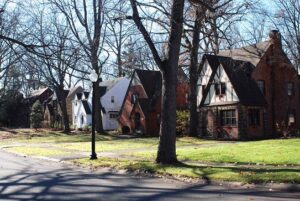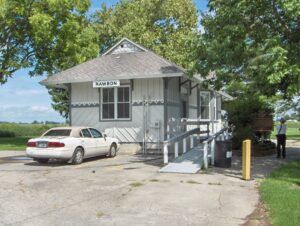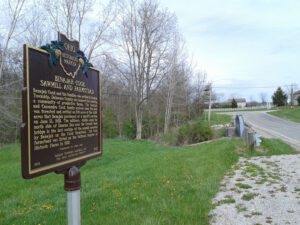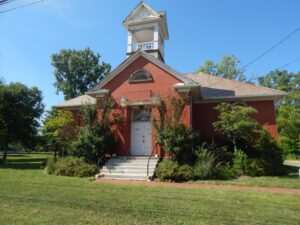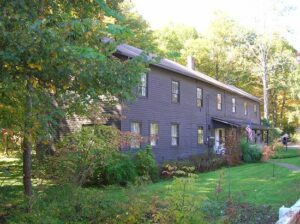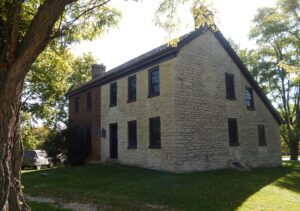, OH
Near this location stood the settlement of African American families known as “The Lett Settlement.” The Lett Settlement was a self-sustaining community of mixed race families, including the Caliman, Guy, and Lett families. The families had formed ties through marriage and common background during the mid-1700s in Virginia and Maryland. These early African American pioneer families came to Ohio as “free people of color,” and began acquiring land in Meigs Township, Muskingum County, and surrounding townships in adjacent counties during the 1820s. They were soon joined by the Brown, Clifford, Earley, Simpson, Tate, and Pointer families. The families of the Lett Settlement were land owners and tax payers in Ohio before the Civil War and challenged the State of Ohio for the right to vote and for access to education during the 1840s, 1850s, and 1860s. (Continued on other side)
, OH
The Union Township Hall was a center of community life from the time of its construction around 1907. The hall included the offices of township government, a community hall, and club meeting rooms, a rarer combination in the 21st century. Local government and services occupied the first floor. The second floor “opera house” retains many original features, including the stage and stage backdrops. The hall hosted many types of entertainment, including church choirs and the Knights of Pythias Band. Leaving the township’s possession, the hall was used by various owners for a church, art studio, and bed and breakfast.(Continued on other side)
, OH
Situated in the township of Boardman and developed in the 1920s, Newport Village was one of Youngstown’s earliest automobile accessible suburban developments. The twenty four and a half acre district is comprised of Jennette Drive, Chester Drive, seven lots on Overhill Road, and a majority of the area on Market Street’s west side. Gently curving streets with both Tudor and Colonial architecture blend into the natural landscape of the area and Mill Creek Park. Newport Village became part of the National Register of Historic Places in 2006.
, OH
The original town plat of Rawson was filed on February 3, 1855, consisting of fifty-five lots in sections 13 and 14 of Union Township, Hancock County on the Frederick Keller and George J. Kelly farms. Several residential and business structures were built in anticipation of completion of a railroad rumored to pass from Fremont through the “Rawson” area on its way to the western boundary of Ohio. Farmers Keller and Kelly named their village Rawson after L.Q. Rawson, President of the railroad company, hoping that the name would encourage him to build through their area. Financial troubles delayed construction causing a standstill in Rawson. Seventeen years later the first locomotive arrived in Rawson, spurring new construction. At that time the railroad was called the Lake Erie and Louisville; in 1879 it was changed to the Lake Erie and Western and in 1922 became part of the Nickel Plate Railroad. (Continued on other side)
, OH
Benajah Cook and the families who settled in Harlem Township, Delaware County are honored for creating a community of productive farms. The Benajah and Cassandra Cook family arrived when the land was forested and settled on 500 acres of the 4,000 acres that Benajah purchased at a sheriff’s auction on June 12, 1807. The millrace, visible along the north side of Duncan Run near the Gorsuch Road bridge is the last vestige of the sawmill operated by Benajah on the Cook farmstead. The Cook farmstead was listed on the National Register of Historic Places in 1977.
, OH
A fine example of the district school building common to Ohio in the early years of the twentieth century, this two-room, red-brick schoolhouse was completed in 1913. Accommodating elementary school children in east Berea and adjacent areas of Middleburg Township, the Berea “Little Red Schoolhouse” replaced an original wood-frame, one-room school built in the late nineteenth century on the same site. No longer active as a school, the building was used by the Berea Fine Arts Club from 1935 to 1980, and subsequently by the Berea Jaycees for meetings and community projects. This historic structure has been carefully restored and opened to public gatherings by the Berea Little Red Schoolhouse Foundation, Inc. It was placed on the National Register of Historic Places in 1975.
, OH
The Ghent Woolen Mill was one of at least thirteen mills built in the Yellow Creek Valley to take advantage of the water power available in the creek’s 400-foot fall across Bath Township. Erected by Messrs. Allen and Bloom in 1832, it was a marginal commercial success and changed hands several times during the 1800s – reportedly because an abundant wolf population in this region made raising sheep a risky venture. In its peak years of operation during the Civil War era the Ghent mill processed as much as 10,000 pounds of wool into finished cloth and yarn annually. It was converted to a machine shop circa 1889 and subsequently into private residences in the late 1890s. The oldest known woolen mill still standing in Ohio, it retains many of its original architectural features.
, OH
Lewis and Elizabeth (Lyons) Kemp were settlers of what became Mad River Township. With their eight children, the Kemps arrived here from Frederick County, Maryland around 1806. The stone part of the house was built shortly thereafter. Lewis donated nearby land for what became known as the “Kemp School,” established in 1815, and for a graveyard, which had its first burial in 1816 or 1817. The Kemps also hosted services of the United Brethren church. The Kemp house is an example of a “Saltbox” type, so called because of the long slope of its rear gable roof. It is believed the house’s brick portion was added around 1832.


